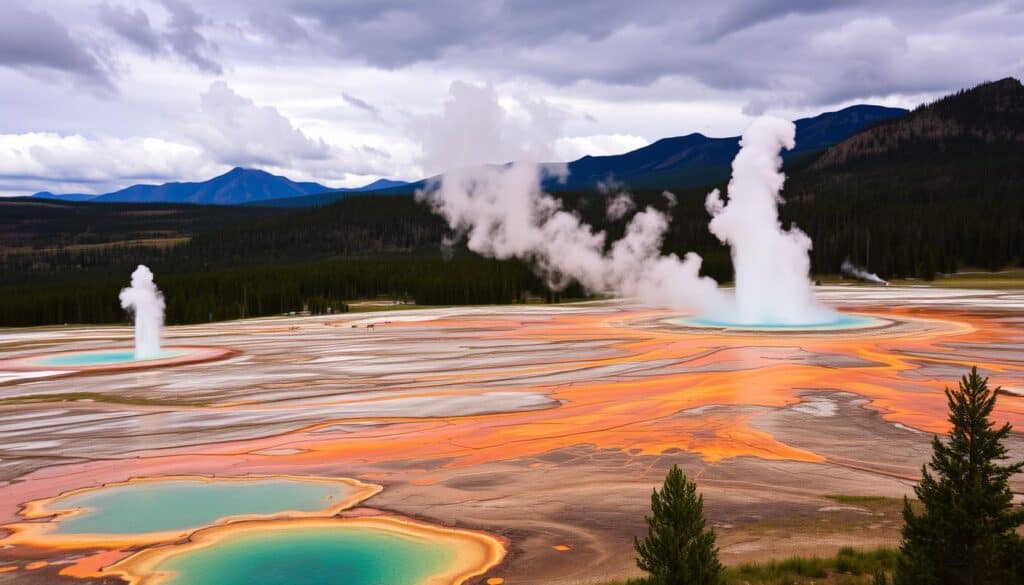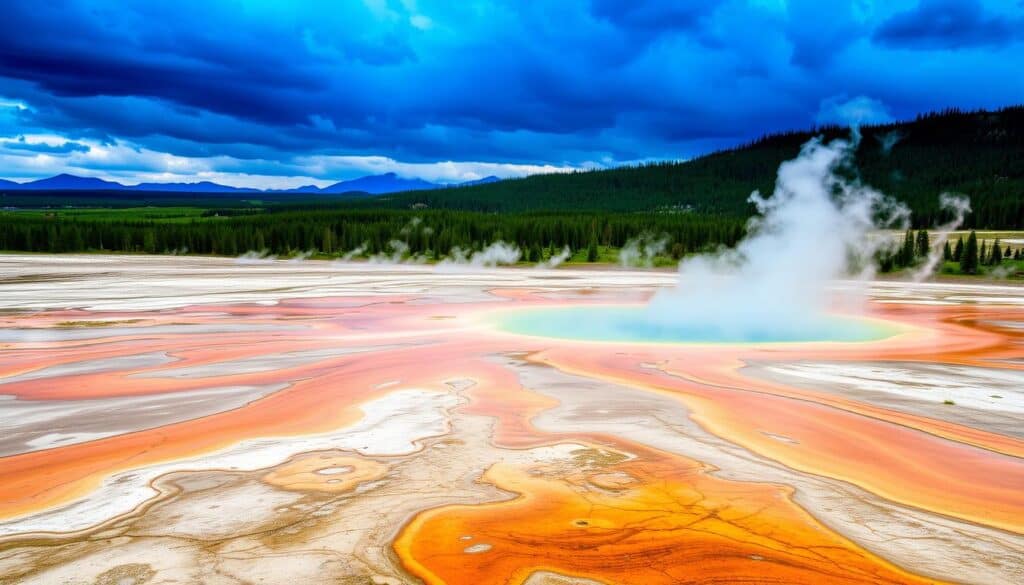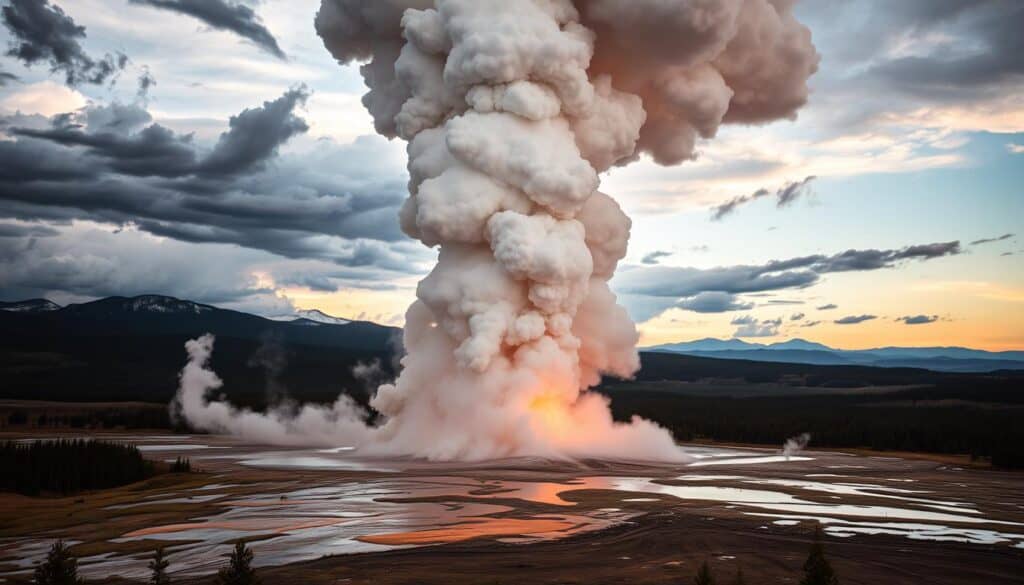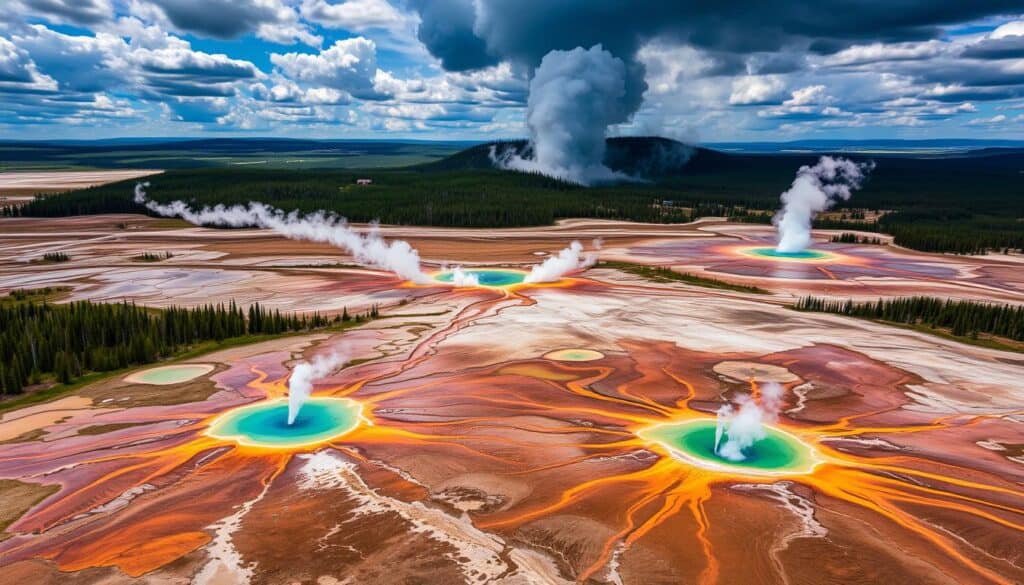A recent yellowstone national park explosion has raised concerns. It happened on July 23, 2024, in the Biscuit Basin area. This area is now closed for the summer.
This event shows how dynamic Yellowstone’s geothermal features are. It’s a reminder of recent geologic events yellowstone.
The explosion was caused by steam and boiling water. Experts say yellowstone national park explosion like this can happen every decade. The water in Yellowstone has a lot of silica, which can cause pressure to build up.
Key Takeaways
- Hydrothermal explosions can occur several times a century in the Yellowstone region.
- The July 23, 2024, explosion is considered to be a size that might occur every decade to a few decades somewhere in the park.
- Smaller hydrothermal explosions in Yellowstone occur almost annually.
- The probability of an individual being injured by a hydrothermal explosion is lower than the occurrence rates of such explosions.
- Data monitoring began in the Norris Geyser Basin in September 2023 to aid in understanding the timing and locations of small hydrothermal explosions.
- The recent geologic events yellowstone have led to a greater understanding of the park’s geothermal features and the importance of monitoring seismic and volcanic activity.
- The yellowstone national park explosion on July 23, 2024, was the first in the park to be clearly captured on video.
Understanding the Yellowstone Caldera
The Yellowstone Caldera is a huge volcanic area in Yellowstone National Park. It’s called a supervolcano because it’s so big and can have huge eruptions. It was made by three big eruptions over 2.1 million years.
A caldera is a big hole that forms when a volcano erupts and then falls in. The Yellowstone Caldera is a huge example, with its last eruption about 640,000 years ago. This eruption was so big it spread ash all over the western United States.
The Yellowstone Caldera is part of a bigger volcanic system. Scientists are very interested in it because of its history of big eruptions. Even though it’s been quiet lately, it’s still very important to study.
https://www.youtube.com/watch?v=F-vn-tZp6kg
- It was formed as a result of three major eruptions over the past 2.1 million years.
- The most recent eruption occurred approximately 640,000 years ago.
- The caldera is considered a supervolcano due to its size and potential for a large-scale eruption.
| Event | Timeframe | Description |
|---|---|---|
| First caldera-forming eruption | 2.1 million years ago | Created a caldera measuring 80 km long and 65 km wide |
| Second caldera-forming eruption | 1.3 million years ago | Produced a large amount of ash and lava |
| Third caldera-forming eruption | 640,000 years ago | Deposited ash across the entire western United States |
The Geology of Yellowstone National Park
Yellowstone National Park sits over a hotspot. Magma from deep inside the Earth comes up, making geothermal features like hot springs and geysers. This area is full of volcanic activity, with many volcanoes and fields.
The park’s geology is really interesting. Volcanic activity yellowstone helped shape it. The geothermal features yellowstone show this, making different landscapes and shapes.

Volcanic Activity in the Region
In Yellowstone, you’ll find stratovolcanoes and cinder cones. Stratovolcanoes are tall, with layers of lava, ash, and more. Cinder cones are small, made from ash and cinder from small eruptions.
Types of Volcanoes Found in Yellowstone
Some key volcanic activity yellowstone includes:
- Stratovolcanoes: tall, conical volcanoes with alternating layers of lava and ash
- Cinder cones: small, steep-sided volcanoes formed from accumulated ash and cinder
These volcanoes make the park’s geothermal features yellowstone special. It’s a great place for those who love geology.
Historical Context of Explosions in Yellowstone
Yellowstone National Park has seen a lot of volcanic activity. This includes big eruptions over the last 2.1 million years. The biggest eruption was about 640,000 years ago. It spread ash all over the western United States.
After that big eruption, the park was quiet for a while. But the park’s hot springs and geysers kept changing.
In recent years, Yellowstone has had smaller eruptions and explosions. One happened on July 23, 2024, in the Biscuit Basin area. Recent geologic events yellowstone
Major Eruptions in History
Some big eruptions happened in Yellowstone. Like the ones at Excelsior Geyser in the 1880s and at Porkchop Geyser in September 1989. These show the park’s power. Visitor information yellowstone volcanic activity helps us understand these events.
Yellowstone also has many small explosions. These happen in the park’s backcountry areas.
When Did They Occur?
Hydrothermal explosions happen in Yellowstone a few times a century. Notable ones were at Black Diamond Pool in 2006 and 2024. These explosions can shoot up to 600 feet high.
Knowing about Yellowstone’s eruptions is key. It helps with recent geologic events yellowstone. And it keeps visitors safe while they explore the park.
Recent Activity in the Yellowstone Supervolcano
The Yellowstone supervolcano is watched closely by the USGS. They look at seismic activity and geothermal features. This helps them understand the park’s volcano and warn of eruptions early.
Recently, the USGS has seen changes in the park’s volcano. They use seismometers and ground deformation to track these changes.
Some recent news includes 82 earthquakes in Yellowstone National Park in December 2024. The biggest earthquake was a 2.7 magnitude on December 15, 2024. Also, Steamboat Geyser had 6 major eruptions in 2024, the least since 2018.
The total caldera subsidence in 2024 was about 3 centimeters. Since early October 2024, it was less than 1 centimeter.
The USGS also watches the park’s hot springs and geysers. Changes in these can show changes in the volcano. The current Volcano Alert Level is NORMAL, and the Aviation Color Code is GREEN.
The seismic activity in Yellowstone National Park is very important. The USGS keeps a close eye on it. They give updates on the seismic activity in Yellowstone National Park.

The data from the USGS helps us understand the Yellowstone supervolcano. By watching seismic activity and geothermal features, scientists can predict eruptions. This helps protect visitors and nearby communities from the supervolcano Yellowstone.
The Science Behind an Eruption
A caldera eruption at Yellowstone is a complex process. It starts with magma moving from deep in the Earth to the surface. This movement is because magma is less dense than the rock around it.
As magma rises, it fills a magma chamber. This is a big, underground tank of molten rock. The size and shape of this chamber can change the eruption’s size and type.
Scientists keep an eye on volcanic activity yellowstone to learn about eruptions. They watch for signs like earthquakes, changes in the ground, and hot water coming out. This helps them guess when another eruption might happen.
- Out of about 50 eruptions in Yellowstone’s history, almost all were simple lava flows.
- The last volcanic activity at Yellowstone was about 70,000 years ago.
- Since the last big eruption 631,000 years ago, there have been about 80 smaller eruptions.
Knowing how eruptions work is key to predicting and getting ready for them. By watching for signs, scientists can warn us early. This helps us prepare for a possible eruption.
| Type of Eruption | Frequency | Impact |
|---|---|---|
| Hydrothermal explosion | Every few years | Forms craters a few meters across |
| Caldera eruption | Every 631,000 years | Forms a large caldera |
Effects of a Possible Eruption
A big yellowstone national park explosion could hurt the area’s plants and animals. It might also make the air dirty and change the weather.
The explosion could harm the park’s famous grizzly bears and wolves. It could also hurt nearby towns with ash, fast-moving hot ash flows, and mudslides.

Keeping park safety yellowstone in mind is very important. We need to have plans ready, watch for earthquakes, and teach people about the dangers.
Some things that could happen from a yellowstone national park explosion are:
- Ash could fall in many states
- The world’s weather might change
- Local animals and plants could be hurt
- Neighboring towns might face ash and hot ash flows
Knowing what could happen from a yellowstone national park explosion helps keep park safety yellowstone top of mind. It helps us prepare for and deal with such a big event.
Emergency Preparedness and Response
In case of a big eruption in Yellowstone, having plans is key. The USGS and National Park Service have set up park safety yellowstone and visitor information yellowstone to keep everyone safe. They have plans for evacuations, dealing with ash, and emergency responses.
To be safe in Yellowstone, knowing the risks is important. The National Park Service shares visitor information yellowstone volcanic activity. They help visitors understand the park’s volcanic past and how to stay safe. Some safety tips include:
- Staying informed about current volcanic activity and park conditions
- Following evacuation procedures and instructions from park rangers
- Being prepared for emergencies with a first aid kit and other essential supplies
By being ready and informed, visitors can enjoy Yellowstone safely. The USGS and National Park Service work hard to give accurate and timely info. They aim to keep park safety yellowstone and make sure everyone has a good time.

| Emergency Plan | Description |
|---|---|
| Evacuation Procedure | Protocol for safely evacuating visitors and staff in the event of an eruption |
| Ash Fall Mitigation | Strategies for minimizing the impact of ash fall on visitors and the environment |
| Emergency Response | Protocols for responding to emergencies and providing aid to those affected |
The Role of the National Park Service
The National Park Service is key in keeping park safety Yellowstone high. They watch and study the park’s volcanic activity. They work with the USGS to track earthquakes and hot spots. This helps them share important visitor information Yellowstone with the public.
To keep park safety Yellowstone top-notch, the National Park Service gives out safety tips. They tell about the park’s volcanic past and future eruptions. They also share how to stay safe while exploring.
Some important safety tips and visitor information Yellowstone from the National Park Service are:
- Stay on the paths and boardwalks.
- Don’t go near unstable ground or hot spots.
- Listen to park rangers and follow signs.
- Know the park’s volcanic history and risks.
By following these tips and staying informed, visitors can enjoy Yellowstone safely. They can see the park’s amazing geothermal features and natural beauty.
Myths and Misconceptions about Yellowstone
Yellowstone National Park is full of myths and misconceptions. Many think it’s ready for a big yellowstone national park explosion. But, predicting when it might happen is hard.
Some believe the USGS can say exactly when an eruption will happen. But, the supervolcano yellowstone is too complex. It’s like trying to guess when a storm will hit.
- The park is not overdue for an eruption
- The USGS cannot predict eruptions with certainty
- The supervolcano yellowstone is not as active as people think
It’s important to know the truth about Yellowstone. By learning about its geology and volcanoes, we can enjoy its beauty more.
The Future of Yellowstone National Park
Looking ahead, Yellowstone National Park’s future is bright. The USGS and National Park Service will keep watching recent geologic events Yellowstone and seismic activity Yellowstone National Park. This helps us understand the park’s volcano better.
This knowledge is key for keeping everyone safe. It helps us get ready for emergencies. This way, visitors and nearby towns stay safe.
Scientists use cool tools like seismometers and ground deformation monitoring. These tools give us clues about the volcano’s activity. By studying recent geologic events Yellowstone, scientists can spot patterns. This helps them guess when eruptions might happen.
Studying seismic activity Yellowstone National Park also helps. It shows how magma and gas move under the ground. This info helps scientists predict eruptions better.
Long-term Monitoring Efforts
Some important parts of long-term monitoring are:
- Tracking seismic activity to find signs of unrest
- Watching ground deformation for surface changes
- Looking at gas emissions to see magma and gas movement
Contributions to Scientific Research
The ongoing research and monitoring are very important. They help us understand Yellowstone’s volcano better. By studying recent geologic events Yellowstone and seismic activity Yellowstone National Park, scientists learn a lot.
This knowledge helps us find ways to lessen the risks of eruptions. It’s a big step towards keeping everyone safe.
Visiting Yellowstone Safely
Visiting Yellowstone National Park safely is very important. The park’s volcanic activity and unique features attract millions. But, there are risks that need to be taken seriously.
The National Park Service has guidelines and safety tips. They help make your visit safe and fun. Remember to stay away from animals and follow the boardwalks in geothermal areas.
Before you go, learn about the park’s safety rules. Know about the dangers like hydrothermal explosions and car accidents. By following the rules and listening to park rangers, you can enjoy Yellowstone’s beauty and wildlife safely.
